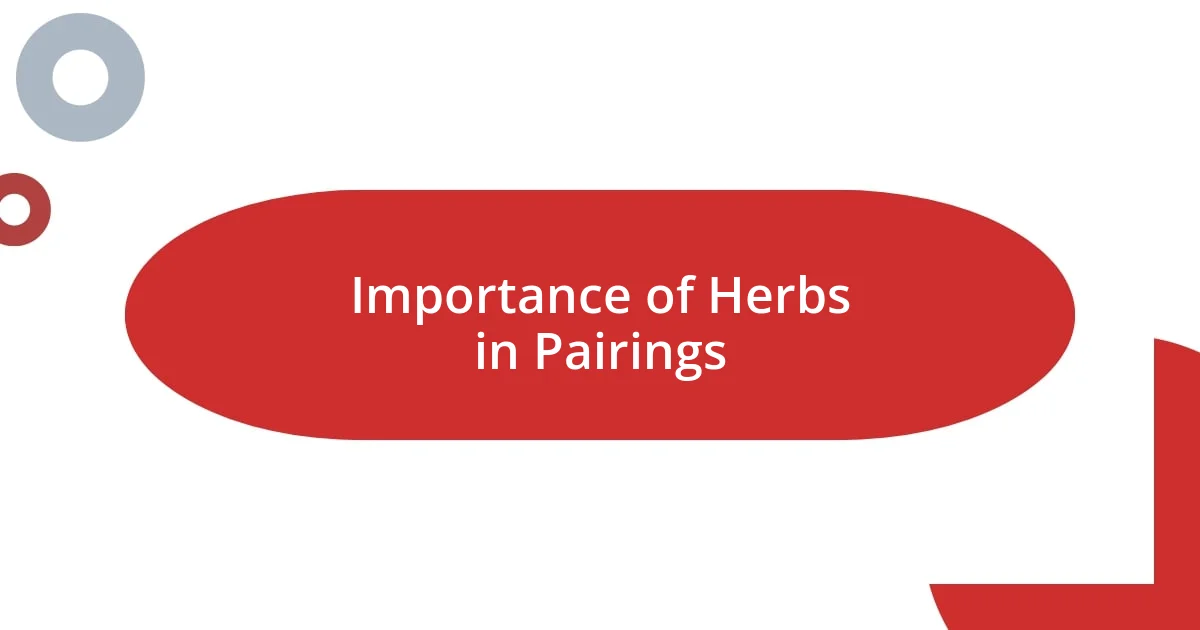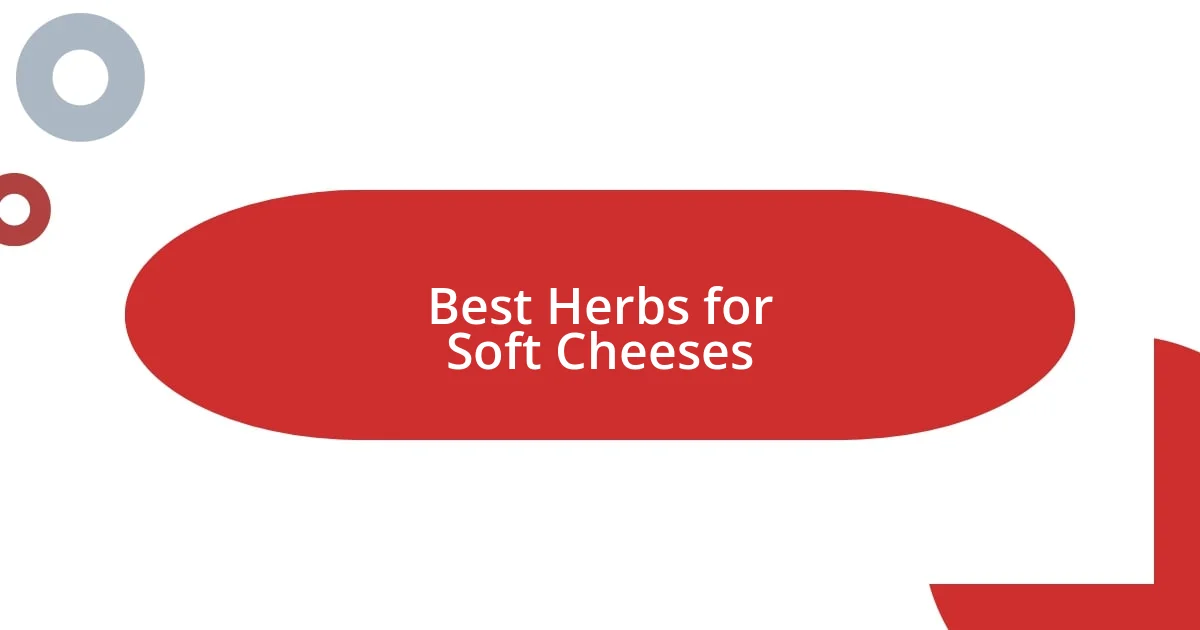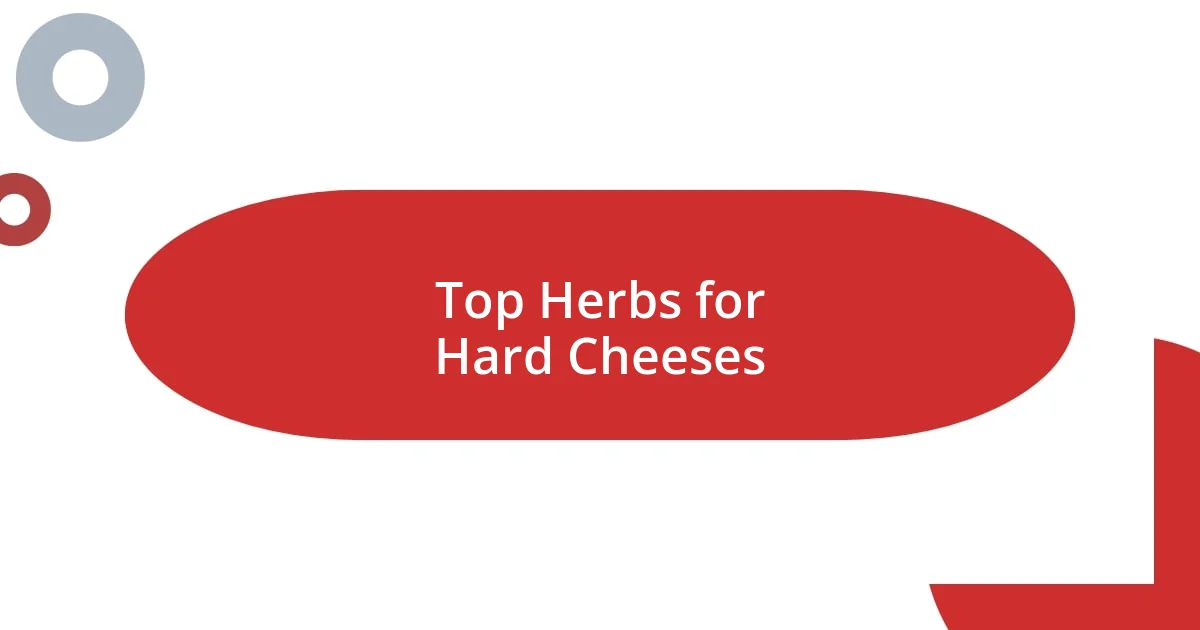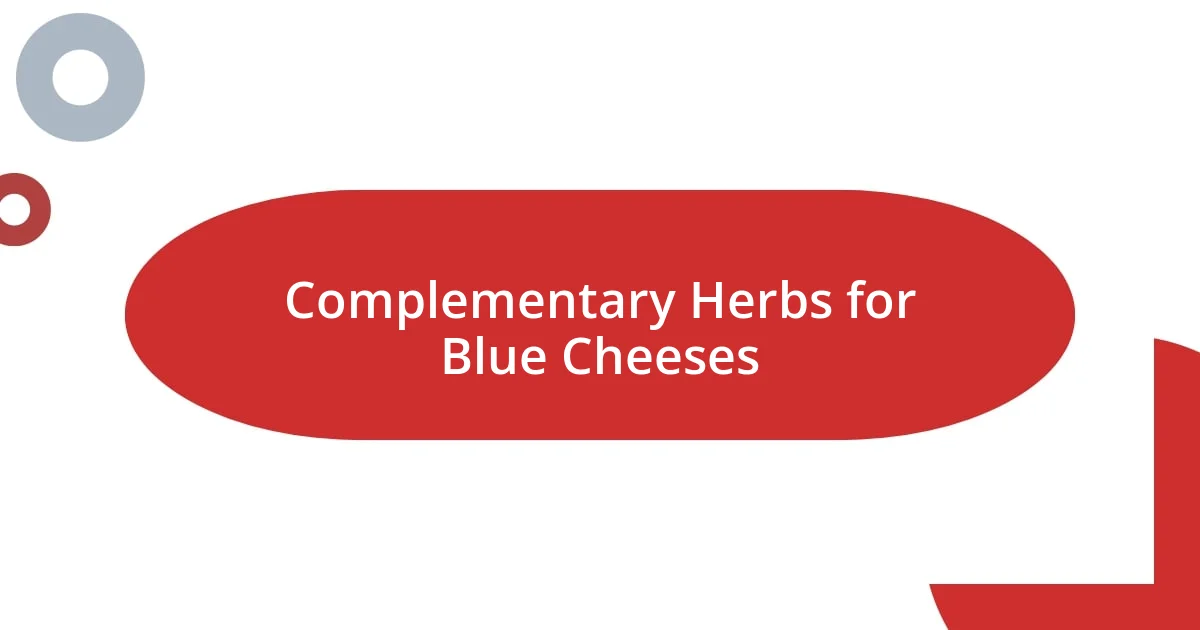Key takeaways:
- Herbs enhance cheese flavors by adding freshness, earthiness, and visual appeal, transforming pairings into gourmet experiences.
- Specific herbs like rosemary, thyme, and basil can complement both soft and hard cheeses, unlocking new dimensions of flavor.
- Creative herb blends, such as basil with oregano or cilantro with lime zest, can invigorate traditional cheese pairings and surprise the palate.

Introduction to Cheese Pairings
Pairing cheese with various herbs can elevate your culinary experience to new heights. I still remember the first time I tasted a well-aged cheddar with fresh rosemary; the combination was a revelation that danced on my palate. Isn’t it fascinating how the right herb can unlock different flavors in cheese?
When you think about cheese pairings, it’s not just about the cheese itself but also about complementing and contrasting flavors. For instance, I often find that a creamy Brie pairs wonderfully with a sprinkle of thyme, adding an aromatic layer that takes each bite to another level. Have you ever experimented with contrasting textures and tastes? It’s an adventure that can lead to delightful surprises.
In my experience, understanding the fundamental principles of flavor pairings—like balancing richness with brightness—paves the way for creative exploration. Just imagine a tangy goat cheese enriched by the floral notes of lavender; it sounds unusual, but trust me, the result is breathtaking. How do you approach your own cheese pairing journeys? Exploring these combinations can reveal much about your personal taste and preferences.

Importance of Herbs in Pairings
When it comes to cheese pairings, herbs play an essential role in enhancing flavors. Herbs can provide a burst of freshness or a touch of earthiness, balancing the creaminess of certain cheeses. I once paired a robust blue cheese with fresh chives, and the zing of the herbs cut through the richness beautifully, creating a harmonious experience that left me craving more.
The beauty of herbs is their versatility. Take basil, for example; it works wonders with soft cheeses like mozzarella. I vividly recall enjoying a Caprese salad with ripe tomatoes, creamy mozzarella, and fragrant basil. Each bite was a delightful fusion of flavors, showcasing how the right herbs can transform cheese into something extraordinary. It’s intriguing to think about how such simple touches can elevate ordinary dishes into gourmet experiences.
Moreover, herbs contribute not just taste, but also aroma and visual appeal. I remember curating a cheeseboard adorned with various herbs like dill and thyme. The vibrant greens added a lovely contrast to the cheeses, making the board inviting and enticing. It really showed me how herbs can engage multiple senses, making the act of cheese pairing not just a culinary task but an enjoyable experience for all involved.
| Herb | Cheese Pairing |
|---|---|
| Rosemary | Aged Cheddar |
| Thyme | Brie |
| Basil | Fresh Mozzarella |
| Dill | Creamy Goat Cheese |

Best Herbs for Soft Cheeses
Soft cheeses are a playground for herbal pairings, and I find that certain herbs really bring out the best in their creamy textures. For instance, my love for fresh chives began during a picnic; a dollop of mascarpone, lightly sprinkled with chives, was a simple yet divine combination that made the experience unforgettable. The mild onion flavor complemented the cheese beautifully, creating a bite that was both refreshing and satisfying.
Here’s a list of my favorite herbs for soft cheeses that I always keep on hand:
- Chives: Their delicate onion flavor enhances fresh cheeses like ricotta.
- Tarragon: Offers a sweet, anise-like flavor that pairs well with creamy cheeses such as goat cheese.
- Oregano: Perfect for stronger soft cheeses like Feta, lending a robust earthiness.
- Parsley: Its bright flavor adds a fresh dimension to cheeses like cream cheese or boursin.
- Chervil: A subtle option that provides a mild anise taste, exceptional with Brie.
Each herb presents an opportunity to explore and play with flavors, like an artist with their palette. When I first tried combining tarragon with a soft goat cheese, I was astonished at how the sweet, slightly licorice notes elevated each bite. It was as though the cheese revealed a new side of itself that I hadn’t recognized before, sparking a creative urge to experiment even further. Exploring these combinations can truly change how we experience soft cheeses.

Top Herbs for Hard Cheeses
When it comes to hard cheeses, I’ve found that the right herbs can elevate these robust flavors to incredible new levels. For example, I remember once dabbling with aged cheddar and rosemary—what a memorable combination! The woodsy notes of rosemary seemed to dance around the sharpness of the cheese, creating a delightful contrast that resonated on my palate long after the last bite.
Have you ever tried pairing thyme with aged gouda? I still recall the first time I did; it was as if I had unlocked a hidden dimension of flavor. The earthiness of the thyme brought out the creamy, caramel undertones of the gouda, making each taste a beautiful revelation. It’s amazing how a simple herb can completely transform the cheese experience, don’t you think?
Another standout pairing is dill with hard feta. I remember serving this duo at a gathering, and the fresh, grassy aroma filled the air. The dill cut through the cheese’s saltiness perfectly, creating a charming balance that everyone loved. Moments like these remind me how herbs aren’t just seasonings—they’re companions that amplify the character of hard cheeses, inviting us to savor and enjoy each bite.

Complementary Herbs for Blue Cheeses
When it comes to blue cheese, I find that certain herbs can profoundly enhance its complex flavors. One herb that truly shines with blue cheese is thyme. I still remember a rainy afternoon when I drizzled blue cheese with a touch of honey and topped it with freshly chopped thyme. The earthy, slightly lemony notes of thyme perfectly complemented the pungent richness of the cheese, creating a delightful experience that opened my mind to new flavor opportunities.
Another herb that pairs exceptionally well is rosemary. I often use it to make a herby cream cheese spread on bruschetta topped with crumbles of blue cheese. The fragrant, resinous quality of rosemary brings a whole new depth to the sharpness of blue cheese. Have you ever tried this combination? I promise, the intriguing interplay between the two will have your taste buds dancing away from the typical cheese pairing routine.
And let’s not forget about sage. I stumbled upon this pairing while experimenting in the kitchen, sautéing sage leaves in butter before tossing them with a warm blue cheese pasta dish. The savory, almost butter-like flavor of the sage elevated the creamy cheese, creating a dish that was utterly comforting. It reminded me that the right herb can not only complement but also transform blue cheese into a truly unforgettable delight.

Creative Herb Blends for Cheese
One herb blend I love for cheese pairings is a mix of basil and oregano, especially with fresh mozzarella. I recall a sunny picnic where I drizzled olive oil over sliced mozzarella, then sprinkled this delightful blend of herbs on top. The sweet basil combined with the slightly peppery oregano created a burst of freshness that complemented the cheese beautifully. Isn’t it fascinating how fresh herbs can transport you to another realm of flavor?
Another fantastic combination is a zesty blend of cilantro and lime zest with creamy cheeses, like goat cheese. I once served this at a dinner party, and the bright, citrusy punch invigorated the richness of the cheese in such an unexpected way. Can you imagine the surprised looks on my guests’ faces? It’s incredible how a simple herb combination can spark joy and elevate a dish to a whole new level.
I also enjoy experimenting with a mix of chives and tarragon when serving soft cheeses like brie. I distinctly remember crafting a herbed cream that included this combination for a late-night snack. The oniony crunch of the chives paired fantastically with the anise-like hints of tarragon, creating layers of taste that were utterly satisfying. Don’t you agree that cooking is really about finding those little moments where flavors come alive in harmony?















